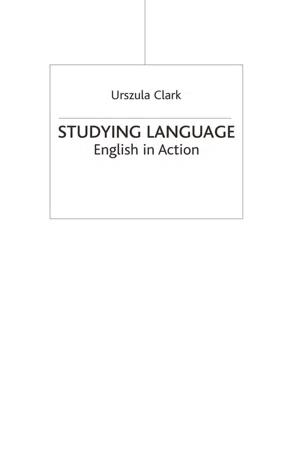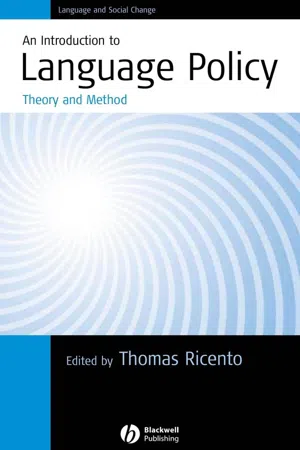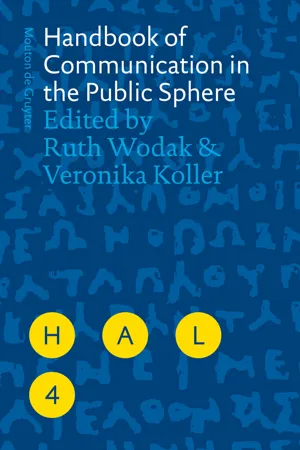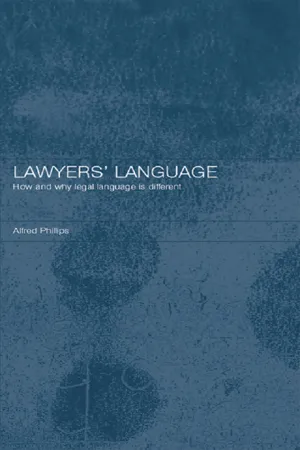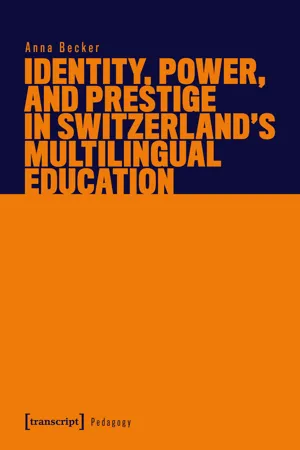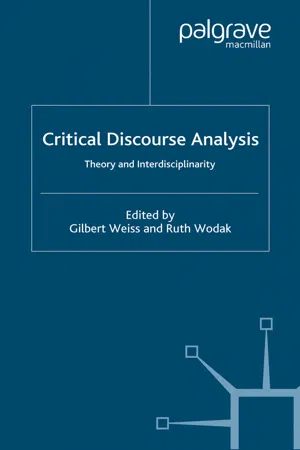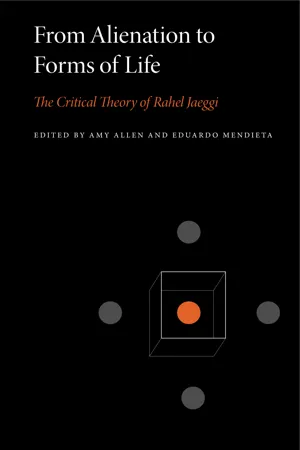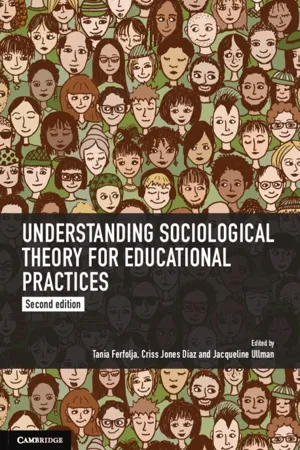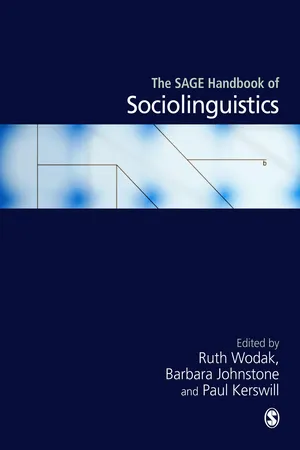Languages & Linguistics
Critical Theory
Critical Theory is a philosophical approach that seeks to understand and critique society and culture, aiming to identify and challenge power structures and inequalities. In the context of languages and linguistics, Critical Theory can be applied to analyze how language is used to perpetuate or challenge social norms and power dynamics, and to explore the relationship between language and power.
Written by Perlego with AI-assistance
Related key terms
1 of 5
12 Key excerpts on "Critical Theory"
- eBook - PDF
Studying Language
English in Action
- Urszula Clark(Author)
- 2017(Publication Date)
- Red Globe Press(Publisher)
❙ 4.5 Critical linguistics The field of critical linguistics arose from two seminal books: Language and Control (Fowler et al. , 1979) and Language as Ideology (Hodge and Kress, 1979). Drawing on sociological and Critical Theory see section 3 above), critical lin-guists took issue with the purely objective model of linguistic criticism, which claimed that the meaning and value of a text could be determined solely by its linguistic construction; that is, the words on a page or the sounds made by speech. Fowler (1986, p. 169) argued that although linguistic structures were themselves objective, ‘their significances in discourse cannot be read off auto-CRITICAL DISCOURSE ANALYSIS 145 matically from the text: a semiotic assessment in relation to cultural factors is required’. That is, communication results not only from what is said or heard, or written and read, but also from an understanding or ‘reading’ of the cultural and social norms associated with the acts of speaking, listening, read-ing and writing (see also Chapter 2). Consequently Fowler (1991, p. 70 describes the central concerns of critical linguistics as ‘the ordering of experi-ence and with the mediation of social relationships and values’. Critical linguistics draws on cultural theory to extend the term ‘text’ to every kind of writing – newspapers, advertisements, leaflets as well as nov-els, plays and poetry – and also to spoken speech. Thus unlike pragmatics, which focuses mainly on spoken speech used in context, or stylistics, which focuses mainly on written literary texts, critical linguistics (and CDA) includes the whole spectrum of texts that speech and writing make possible. This necessitates a specific model of linguistics, and one has been drawn from systemic functional linguistics (see Halliday, 1971, 1973). Systemic functional linguistics is concerned with how language is used in real life and the way in which linguistic structure is related to communicative function and social value. - eBook - PDF
An Introduction to Language Policy
Theory and Method
- Thomas Ricento(Author)
- 2009(Publication Date)
- Wiley-Blackwell(Publisher)
This early work in language policy was seen as having practical value for newly independent, multilingual and multiethnic states facing the problems of national unity and socio-economic development. The traditional approach was extended to developed countries, where language policies were believed to be useful for integrating linguistic minorities into mainstream socio-economic systems. In contrast to this optimistic traditional research, a critical approach acknowledges that policies often create and sustain various forms of social inequality, and that policy-makers usually promote the interests of dominant social groups. Early critical 43 Critical Theory research on South Africa was especially important in leading to disillusionment with traditional language-policy research. 1 A second meaning of critical is that it refers to research aimed at social change. This research examines the role of language policies in social, political, and economic inequality, with the aim of developing policies that reduce various forms of inequality. For instance, prominent researchers (e.g., Cummins, 2000), academic journals (e.g., the Bilingual Research Journal ), and professional associations (e.g., the National Association for Bilingual Education) in the sub-discipline of bilingual education are committed to policies promoting the maintenance and revitalization of indigenous and heritage languages as necessary for achieving social justice. Such research is fundamentally opposed to positivist approaches that emphasize the researcher’s “objectivity” and distance from the “subjects” of research. In its concern for social change and social justice, CLP research highlights ethical questions of policy, as well as of research methodology. A third meaning of critical is that it refers to work that is influenced by Critical Theory. Critical Theory includes a broad range of work examining the processes by which systems of social inequality are created and sustained. - Ruth Wodak, Veronika Koller, Ruth Wodak, Veronika Koller(Authors)
- 2008(Publication Date)
- De Gruyter Mouton(Publisher)
For all those concerned with Critical Dis-course Analysis, application of the results is important, be it in practical sem-inars for teachers, doctors and bureaucrats or in the writing of expert opinions or devising schoolbooks. Thompson (1990) discusses the concepts of ideology and culture and the re-lations between these concepts and certain aspects of mass communication. He points out that the concept of ideology first appeared in late 18 th century France and has thus been in use for about two centuries. The term has been given a range of functions and meanings at different times. For Thompson, ideology refers to social forms and processes within which, and by means of which, sym-bolic forms circulate in the social world. Ideology, for Critical Discourse Analy-sis, is seen as an important means of establishing and maintaining unequal power relations. Critical Discourse Analysis takes a particular interest in the ways in which language mediates ideology in a variety of social institutions (see also Eagleton 1994). Critical theories, thus also Critical Discourse Analysis, are afforded special standing as guides for human action. They are aimed at producing enlighten-ment. Such theories seek not only to describe and explain, but also to root out a particular kind of delusion. Even with differing concepts of ideology, Critical Theory seeks to create awareness in agents of how they might be deceived about their own needs and interests. This was, of course, taken up by Pierre Bour-dieu’s concepts of violence symbolique and méconnaissance (Bourdieu 1989). One of the aims of Critical Discourse Analysis is thus to “demystify” discourses by deciphering ideologies. For Critical Discourse Analysis, language is not powerful on its own – it gains power by the use powerful people make of it.- N. J. Enfield, Paul Kockelman, Jack Sidnell(Authors)
- 2014(Publication Date)
- Cambridge University Press(Publisher)
In making these arguments, Kockelman introduces some of the key concepts and claims of computer science, and Interdisciplinary perspectives 601 shows their fundamental importance to the concerns of linguistic anthro- pology. This reveals the ways some of the core contentions and methods of linguistic anthropologists can be productively applied to, and extended using the digitally mediated, computationally processed, and pervasively networked infrastructure of modern social environments – opening up not only a new set of topics, but also a new set of techniques. 602 P A U L K O C K E L M A N , J A C K S I D N E L L , A N D N . J . E N F I E L D 24 Linguistic anthropology and Critical Theory Paul Kockelman 24.1 Cages, claws, and keys As used here, the term Critical Theory refers to work produced by a set of thinkers who might best be understood as shadows of the enlightenment – Bacon and Hobbes, Kant and Hegel, Marx and Freud, Darwin and Nietzsche, Saussure and Peirce, among many others. 1 While these thinkers are, to be sure, radically heterogeneous in many respects, they all pondered the limits (and sometimes the seeming limitlessness) of knowledge and power. In some sense, they all understood human-specific forms of agency, and medi- ation more generally, to be simultaneously cage, claw, and key. This chapter is meant to characterize the core theoretical claims of linguistic anthropology while, simultaneously, critiquing the cultural logic underlying its practices of claim-making. The title, then, is meant to do double-work: we will take a critical look at theory in the discipline of linguistic anthropology by foregrounding its dependence on certain moves in Critical Theory.- eBook - ePub
Lawyers' Language
The Distinctiveness of Legal Language
- Alfred Phillips(Author)
- 2003(Publication Date)
- Routledge(Publisher)
Driven as social beings to communicate, unless we believe in the powers of telepathy, we are stuck with language, warts and all. In formulating their critique, even the exponents of critical linguistics have no option but to make use of language. The instrument (language) employed for the analysis is identical with the object of the analysis itself (language). So, in constructing its Critical Theory, critical linguistics cannot but build a trap for itself. Later in the chapter, the review of deconstructionism and of the position of ideology in neo-Marxist thought, with their threats to the integrity of the legal text, reveals a mechanism whereby each seeks to escape its own trap. Rhetoric It is an imperative to look closely at rhetoric as an introduction or background to critical linguistics, at least in relation to law. Perhaps even, in its own terms, rhetoric is to be regarded as the umbrella term covering critical linguistics. Rhetoric is classically defined as the art of persuasion by discourse, discourse in this context being used in its non-technical sense. Speech or argument, therefore, is to be measured not by whether it is true, valid or sincere but by whether it is effective in persuading those to whom it is addressed. The elimination of the dimension of referentiality intrinsic to language, common to the other theories to be discussed here, emerges clearly in the definition. To call rhetoric an art inevitably imports the many facets of an art: a study or a legitimising discourse; a set of practices or techniques; and along with these a nuance of art fulness. Nowadays, in ordinary usage, we pick up two of these aspects in the phrases: ‘rhetorical question’ and ‘mere rhetoric’ - Anna Becker(Author)
- 2023(Publication Date)
- transcript Verlag(Publisher)
Education, Languages, and Power 2.1 Introduction This chapter’s focus is to situate this study in the wider field of critical multilingual education research by drawing from educational and applied linguistics literature. Its aim is to elaborate the underlying framework of power mechanisms, as well as explicit and implicit language education policies, in schools in order to analyze and interpret study subjects’ perspectives on and experiences with language hierarchies and ideologies thereafter. First, the relationship between power and education in a broader sense will be discussed, which will serve as the study’s theoretical foun- dation (2.2). Second, the aspect of language will be integrated into the discussion of power relations in order to demonstrate how language can both connect cultur- ally diverse groups and improve mutual understanding, but how it can also cre- ate barriers and engender social exclusion (2.3). The role of English in particular, as mediator or troublemaker, is examined in section 2.4, following a relatively new re- search paradigm of (unequal) Englishes. These power dynamics are further elucidated through the concept of critical multiculturalism (2.5). Plurilingual identities are ana- lyzed with regard to individuals’ linguistic repertoires and the concepts of heteroglos- sia and translanguaging in section 2.6. Finally, ways in which multilingual education can be practiced through different pedagogic approaches, such as translanguaging or content and integrated language learning (CLIL), are presented. 34 Identity, Power, and Prestige in Switzerland’s Multilingual Education 2.2 Education and Power The starting-point of critical elabo- ration is the consciousness of what one really is, and is ‘knowing thy- self’ as a product of the historical process to date which has deposited in you an infinity of traces, without leaving an inventory.- eBook - PDF
Critical Discourse Analysis
Theory and Interdisciplinarity
- G. Weiss, R. Wodak, G. Weiss, R. Wodak(Authors)
- 2002(Publication Date)
- Palgrave Macmillan(Publisher)
Introduction 13 The shared perspective and programme of CDA relate to the term ‘criti- cal’, which in the work of some ‘critical linguists’ could be traced to the influence of the Frankfurt School or Jürgen Habermas (see above). Nowadays this concept is conventionally used in a broader sense, recognizing, in Fairclough’s words, ‘that, in human matters, interconnections and chains of cause-and-effect may be distorted out of vision. Hence “critique” is essen- tially making visible the interconnectedness of things’ (Fairclough, 1995, p. 747; see also Connerton, 1976, pp. 11–39). References to the contribution of Critical Theory to the understanding of CDA and the notions of ‘critical’ and ‘ideology’ are of particular importance (see Anthonissen, 2001, for an extensive discussion of this issue). Thompson (1990) discusses the concepts of ideology and culture and the relations between these concepts and certain aspects of mass communication. He points out that the concept of ideology first appeared in late eighteenth-century France and has thus been in use for about two centuries. The term has been given a range of different functions and meanings at different times. For Thompson, ideology refers to social forms and processes within which, and by means of which, symbolic forms circulate in the social world. Ideology, for CDA, is seen as an important means of establishing and maintaining unequal power relations. CDA takes a particular interest in the ways in which language mediates ideology in a variety of social institutions. For Eagleton, moreover, the study of ideology has to bear in mind the variety of theories and theorists that have examined the relation between thought and social reality. All the theories assume ‘that there are specific historical reasons why people come to feel, reason, desire and imagine as they do’ (1994, p. 15). Critical theories, and thus also CDA, are afforded special standing as guides for human action. - eBook - PDF
Beyond the Boundaries
A Transdisciplinary Approach to Learning and Teaching
- Douglas Kaufman, David Moss, Terry A. Osborn, Douglas Kaufman, David Moss, Terry A. Osborn(Authors)
- 2003(Publication Date)
- Praeger(Publisher)
As a result, a critical approach to foreign language education will involve the decentralization of the curriculum and instruc- tional reform process. Therefore, language educators at all levels will have a significant voice in a critical reformation of the field. A METALINGUISTIC KNOWLEDGE BASE Critical insights into foreign language education suggest that the cur- riculum will need to move beyond the formula of "four skills plus cul- Not-So-Foreign Languages 39 ture" to include issues of the ways in which languages function in a socio- cultural context such as the U.S. democracy. A partial list of issues that would need to be explored includes • the social context of language use, • the nature and implications of code switching and code mixing, • bilingualism and multilingualism as individual and social norms, • ideology and language, • issues of language standardization and linguistic purism, • the concept of linguistic legitimacy, • the historical development of language, and • the nature of literacy and the concept of multiple literacies (see Reagan & Osborn, 2002). Though traditionally such issues have been dealt with only in sporadic ways in foreign language classrooms, based on the understanding and comfort level of individual teachers, changes in curricula could include the investigation of such issues through the use of a critical language cur- riculum. As part of the critical language curriculum, I propose the imple- mentation of the CLIC. CRITICAL LANGUAGE INQUIRY CYCLE The CLIC is based on a critical approach to qualitative research. Quali- tative researchers view the truth as holistic, consider the researcher's val- ues intrinsic to the research process, and acknowledge the evolving nature of research questions and activity. The CLIC does not presuppose an overly specific research question nor a particularly predictable outcome. It is a process of exploration that can be entered into by students and teacher together, in their individual contexts. - eBook - PDF
From Alienation to Forms of Life
The Critical Theory of Rahel Jaeggi
- Amy Allen, Eduardo Mendieta(Authors)
- 2018(Publication Date)
- Penn State University Press(Publisher)
Chapter 6 What’s Critical about Critical Theory?—Redux Rocío Zambrana The work of our time [is] to clarify to itself (critical philosophy) the mean- ing of its own struggle and its own desires. This is work for the world and for us. It can only be the work of joint forces. —Marx 1 In her 1985 essay “What’s Critical about Critical Theory? The Case of Habermas and Gender,” Nancy Fraser offered a decisive critique of Jürgen Habermas’s theory of communicative action. 2 Habermas’s dis- tinction between system and lifeworld—itself based on a distinction between the material and symbolic reproduction of society—ignores the gendered character of social reproduction. One could only con- sider the lifeworld as a site of communicative interaction, for instance, if one ignores the fact that women’s exploitation in great part takes place within “socially-integrated action contexts” or if one ignores the feminization of work within “system-integrated action contexts.” 3 Habermas’s Critical Theory lacks critical power, Fraser argues, because it fails to “clarify the struggles and desires of the age.” It does not offer an account of the gendered character of social reproduction because it fails to take seriously the insights of the feminist movement—insights 99 What’s Critical about Critical Theory?—Redux that are not peripheral to an account of society, that ought to shape our understanding of social reproduction, and that ought to inform how we understand critique. Fraser opens her essay with the suggestion that Marx’s 1843 defini- tion of Critical Theory as the clarification of the struggles and desires of the age is unmatched given its distinctively political character. 4 Critical Theory remains critical if it is oriented by the potential for social transformation embedded in the concrete struggles of the pres- ent. This political commitment, however, sets a theoretical agenda for Critical Theory. - (Author)
- 2018(Publication Date)
- Cambridge University Press(Publisher)
These included, for example, researching and creating an audio- visual representation of family histories, designing a multilingual cyberbullying campaign, and researching and presenting multilingual folktales and fairy-tales. In the following analysis, Bourdieu’s theoretical frame facilitates critical under- standings of how the linguistic and cultural skills and abilities of a diverse group of students were viewed in the broader educational context and then applied in class- rooms. It offers an opportunity to consider the particular ways these classrooms inhibited or promoted equitable learning outcomes for students. The findings pre- sented here situate language as a strong form of capital and examine teachers’ and students’ recognition and valuing of students’ pre-existing linguistic habitus. The analysis considers how recognition of students’ linguistic capital was realised, and began to transform the field, influencing what teachers did, what they said and how they taught. A critical reflection on the role of habitus elucidates how the education field of these classrooms functioned to legitimise linguistic equality and worked to include students’ myriad knowledges, skills and understandings. Analysis and discussion These young people and their teachers transformed their everyday practice and exchanges by actively examining the diverse multimodal, socio-cultural and socio-linguistic practices in their everyday worlds. This transformation required teachers’ active development of new curriculum and pedagogies that enabled stu- dents’ ‘repertoires of linguistic practice’ to be revealed. Teachers not only asked 220 Part 3: Using Critical Theory students to share their practices and experiences in informal interviews, they con- tinued to work with, and elaborate on, the information they collected. Classroom work began with students being presented with their interview data in the form of graphs and tables.- eBook - PDF
- Ruth Wodak, Barbara Johnstone, Paul E Kerswill, Ruth Wodak, Barbara Johnstone, Paul E Kerswill(Authors)
- 2010(Publication Date)
- SAGE Publications Ltd(Publisher)
Linguistic anthropologists ana-lyse cross-discourse practices, that vary cross-culturally, involving, for instance, the violation of presumed universal maxims such as those entailed in Grice’s principle of cooperation (1975). Such investigations include among many others Ochs (1988) on Madagascar and Haviland (1997) on Tzotzil (Maya). In sum, critical social theories on the link between power and discourse have made us aware of two core, underlying assumptions in particular. First, discourse and power are co-constitutive. Discourse is constitutive of power by privileging certain perceptions of (social) reality and excluding others. Societal discourses shape and sustain dis-criminatory and stigmatizing practices and, as such, bring about ‘disorders of discourses’ (Wodak, 1996) in which some human beings are muted while the speaking authority of others is naturalized. Power relationships predispose which individuals are in a position to participate in and shape dis-courses. Secondly, however, discourse is also seen as bearing emancipatory potential, being the place where power and authority might eventually be challenged and resisted. In general, therefore, language and communication as the primary dis-cursive practices are perceived as playing a critical role both in the perpetuation as well as the trans-formation of powerful discourses. In the following, we will show how empirical sociolinguistic research has sought to exemplify these core assumptions. We have chosen some of the most prominent fields of research in contemporary sociolinguistics, i.e. studies on national identity and racism, social conventions (such as politeness), field linguistics and academic research, in order to show how the discipline of sociolinguistics has approached the interplay between power and discourse. - eBook - PDF
- C. Wallace(Author)
- 2003(Publication Date)
- Palgrave Macmillan(Publisher)
The students in the Critical Reading class in my study were not, unlike Halliday’s students, students of linguistics. However, many had studied English grammar, though not Hallidayan grammar, in some detail. One of the advantages which many foreign learners of English have over native speakers of the language is that they already possess explicit kinds of knowledge about language. As I note in Wallace (1992a: 69), they have a metalanguage, a way of talking about texts largely in terms of traditional categories such as ‘pronoun’, ‘subject’ and ‘object’. It means that this knowledge can be put to use in looking not just at propositional content but at ideological assumptions. With a strong grammatical knowledge background, many of the students in my particular study quite readily accepted the introduction of the Hallidayan functions – ideational, interpersonal and textual – early on in the course, along with discussion of the more salient lexico/grammatical exponents of each func- tion, that is the more ‘exposed’ parts of the grammar. Critical literacy procedures In this section I would like to bring together the discussion of criticality in section one, and the introduction of a language model in section two by offering an account of a framework or pedagogic procedure which illustrates how critical language study informs teaching and learning. As a heuristic then I should like to locate these two strands within some overall framework, that is offer some mapping out of the territory of critical literacy pedagogy. One kind of framework which makes strong reference to criticality, although it is ostensibly concerned with what it calls the design of social futures more widely, is that offered by the NLG (Cope and Kalantzis 2000), whose work was introduced in Chapter 1. This model moves from situated practice, to overt instruction, to critical framing concluding with transformed practice.
Index pages curate the most relevant extracts from our library of academic textbooks. They’ve been created using an in-house natural language model (NLM), each adding context and meaning to key research topics.
